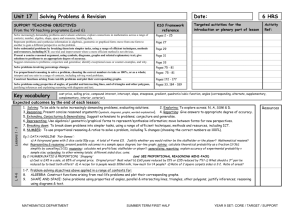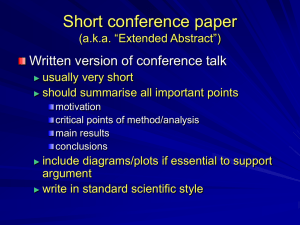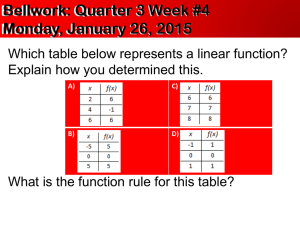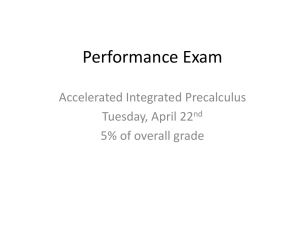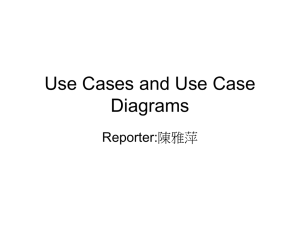year_9_core_summer_term_1
advertisement
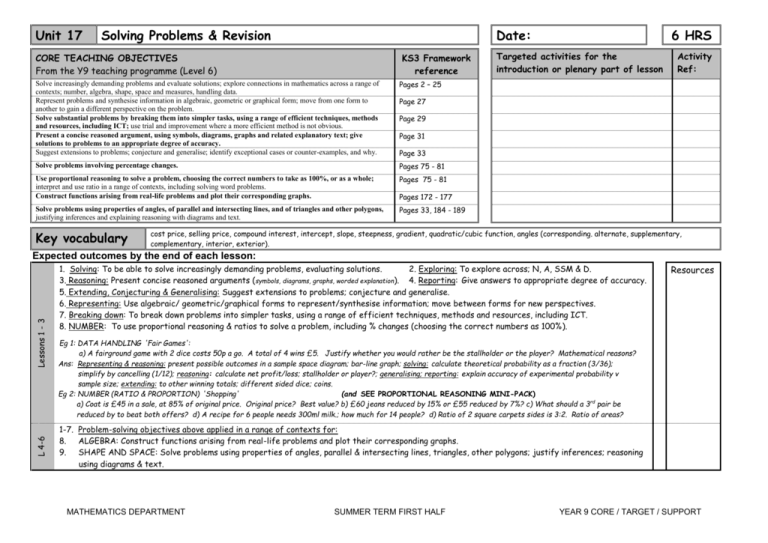
Unit 17 Solving Problems & Revision Date: CORE TEACHING OBJECTIVES From the Y9 teaching programme (Level 6) KS3 Framework reference Solve increasingly demanding problems and evaluate solutions; explore connections in mathematics across a range of contexts; number, algebra, shape, space and measures, handling data. Represent problems and synthesise information in algebraic, geometric or graphical form; move from one form to another to gain a different perspective on the problem. Solve substantial problems by breaking them into simpler tasks, using a range of efficient techniques, methods and resources, including ICT; use trial and improvement where a more efficient method is not obvious. Present a concise reasoned argument, using symbols, diagrams, graphs and related explanatory text; give solutions to problems to an appropriate degree of accuracy. Suggest extensions to problems; conjecture and generalise; identify exceptional cases or counter-examples, and why. Pages 2 – 25 Solve problems involving percentage changes. Pages 75 - 81 Use proportional reasoning to solve a problem, choosing the correct numbers to take as 100%, or as a whole; interpret and use ratio in a range of contexts, including solving word problems. Construct functions arising from real-life problems and plot their corresponding graphs. Pages 75 - 81 Solve problems using properties of angles, of parallel and intersecting lines, and of triangles and other polygons, justifying inferences and explaining reasoning with diagrams and text. Pages 33, 184 - 189 Key vocabulary 6 HRS Targeted activities for the introduction or plenary part of lesson Activity Ref: Page 27 Page 29 Page 31 Page 33 Pages 172 - 177 cost price, selling price, compound interest, intercept, slope, steepness, gradient, quadratic/cubic function, angles (corresponding. alternate, supplementary, complementary, interior, exterior). L 4-6 Lessons 1 - 3 Expected outcomes by the end of each lesson: 1. Solving: To be able to solve increasingly demanding problems, evaluating solutions. 2. Exploring: To explore across; N, A, SSM & D. 3. Reasoning: Present concise reasoned arguments (symbols, diagrams, graphs, worded explanation). 4. Reporting: Give answers to appropriate degree of accuracy. 5. Extending, Conjecturing & Generalising: Suggest extensions to problems; conjecture and generalise. 6. Representing: Use algebraic/ geometric/graphical forms to represent/synthesise information; move between forms for new perspectives. 7. Breaking down: To break down problems into simpler tasks, using a range of efficient techniques, methods and resources, including ICT. 8. NUMBER: To use proportional reasoning & ratios to solve a problem, including % changes (choosing the correct numbers as 100%). Resources Eg 1: DATA HANDLING 'Fair Games': a) A fairground game with 2 dice costs 50p a go. A total of 4 wins £5. Justify whether you would rather be the stallholder or the player? Mathematical reasons? Ans: Representing & reasoning: present possible outcomes in a sample space diagram; bar-line graph; solving: calculate theoretical probability as a fraction (3/36); simplify by cancelling (1/12); reasoning: calculate net profit/loss; stallholder or player?; generalising; reporting: explain accuracy of experimental probability v sample size; extending: to other winning totals; different sided dice; coins. Eg 2: NUMBER (RATIO & PROPORTION) 'Shopping' (and SEE PROPORTIONAL REASONING MINI-PACK) a) Coat is £45 in a sale, at 85% of original price. Original price? Best value? b) £60 jeans reduced by 15% or £55 reduced by 7%? c) What should a 3rd pair be reduced by to beat both offers? d) A recipe for 6 people needs 300ml milk.; how much for 14 people? d) Ratio of 2 square carpets sides is 3:2. Ratio of areas? 1-7. Problem-solving objectives above applied in a range of contexts for: 8. ALGEBRA: Construct functions arising from real-life problems and plot their corresponding graphs. 9. SHAPE AND SPACE: Solve problems using properties of angles, parallel & intersecting lines, triangles, other polygons; justify inferences; reasoning using diagrams & text. MATHEMATICS DEPARTMENT SUMMER TERM FIRST HALF YEAR 9 CORE / TARGET / SUPPORT Unit 18 SSM 4a: Problem-Solving & Transformations CORE TEACHING OBJECTIVES From the Y9 teaching programme (Level 6) Solve problems using properties of parallel and intersecting lines, and of triangles and other polygons, justifying inferences and explaining reasoning with diagrams and text. Visualise and use 2-D representations of 3-D objects; analyse 3D shapes through 2-D projections, including plans and elevations. Present a concise, reasoned argument, using symbols, diagrams and related explanatory text; give solutions to problems to an appropriate degree of accuracy. Date: KS3 Framework reference Targeted activities for the introduction or plenary part of lesson 3HRS Activity Ref: Pages 184 – 189 Pages 198 - 201 Pages 30 - 31 Key vocabulary Lessons 1 & 2 parallel, intersecting, corresponding angle, alternate angle, interior angle, exterior angle, tessellate, cross-section, line of symmetry, plane of symmetry, reflection, translation, rotation, congruent, similar, polygon, square, rectangle, rhombus, parallelogram, kite, pentagon, hexagon, octagon. Expected outcomes by the end of each lesson: 1. To be able to visualise and sketch 2-D shapes. Eg: 4 visualisation exercises, Framework, Page 185. Resources: 2. Know and use angle & symmetry properties of polygons. 3. To know and use angle properties of parallel & intersecting lines. 4. To be able to use these properties to solve problems. To be able to analyse 3-D shapes through 2-D projections, cross-sections and planes of symmetry. Eg: Find 3 examples of regular polygons which can tessellate on their own. Explain why they can whilst other polygons cannot. Eg 1: Which solid shape(s) have triangular front and side elevations, and a square plan view? Lesson 3 Eg 2: Which solids might cast these shadows? Eg 3: MATHEMATICS DEPARTMENT This cube has been sliced to give a square X-section. Can you slice it to give a rectangle? a triangle? a hexagon? SUMMER TERM (FIRST HALF) YEAR 9 CORE Unit 19 Handling Data 3 (Survey & interpretation) CORE TEACHING OBJECTIVES From the Y9 teaching programme (Level 6) Discuss how data relates to a problem; identify possible sources, including primary and secondary sources. Gather data from specified secondary sources, including printed tables and lists from ICT-based sources. Find summary values that represent the raw data, and select the statistics most appropriate to the problem. Select, construct and modify, on paper and using ICT, suitable graphical representations to progress an enquiry. Interpret graphs and diagrams and draw inferences to support or cast doubt on initial conjectures; have a basic understanding of correlation. Compare two or more distributions and make inferences, using the shape of the distributions, the range of data and appropriate statistics. Communicate interpretations and results of a statistical enquiry using selected tables, graphs and diagrams in support, using ICT as appropriate. Solve substantial problems by breaking them into simpler tasks, using a range of efficient techniques, methods and resources, including ICT. KS3 Framework reference Date: 5 HRS Targeted activities for the introduction or plenary part of lesson Activity Ref: Pages 249 - 251 Page 255 Pages 256 – 261 Pages 263 - 267 Pages 268 – 271 Page 273 Pages 274 - 275 Pages 28 - 29 *** These objectives overlap significantly with Unit HD1 (excluding underlined Objectives). Emphasis in HD3 is on application to more complex problems. Key vocabulary data: (raw data, representative, bias, census, sample, primary / secondary source, data log, two-way table, discrete, continuous); statistics: (estimate of mean / median, cumulative frequency, distribution, stem-and leaf diagram); data display: (line of best fit, cumulative frequency graph, scatter graph). Expected outcomes by the end of each lesson: 1. To review and extend how to plan and carry out procedure to answer a statistical enquiry, from secondary sources. Eg: Compare Rainfall in England and Greece Discuss data needed to answer a specified problem. Identifying data sources, especially secondary sources, (e.g. Internet, published lists and tables). - Design & use two-way tables. - Calculate averages and ranges. - Construct graphs and diagrams (paper / ICT): To be able to plan and carry out a more complex statistical enquiry, with greater independence, as in: Resources: Query: Do more girls smoke than boys? frequency diagrams &polygons, line graphs; scatter diagrams. - Interpret graphs & diagrams; draw inferences. - Compare 2 or more sets of data using the graph shapes & appropriate statistics. - Communicate results & interpretations. 2. To use this review to appreciate the need to: - break substantial problems into simpler tasks; - use efficient techniques and methods; - use efficient resources (such as ICT). MATHEMATICS DEPARTMENT Lessons 3 - 5 Lessons 1-2 - Conjecture: More boys smoke than girls in the under-16 group, but more girls smoke than boys over 16. Sources: Search Internet, CD-ROMs or printed lists for data on smoking numbers, age groups, social class, region… Bias: Identify sources of bias & response: numbers may depend on region, social class, year of survey, survey source, … focus on 1 region only / analyse according to region … 2-way tables: organise data in 2-way table so can compare boys v girls (eg: Framework, page 255). Statistics: calculate most appropriate averages, and range. if a large set of data already grouped, find: - estimated mean and estimated range; - estimate median and interquartile range. Construct: graphs and diagrams. Compare: using graph shapes and statistics. Interpret / Infer: to support or reject hypothesis. Communicate: results (eg: Framework, page 273 – 275). SUMMER TERM (FIRST HALF) YEAR 9 CORE Resources: MATHEMATICS DEPARTMENT SUMMER TERM (FIRST HALF) YEAR 9 CORE
